Ungraded: Avant-garde assessment Glenlawn Collegiate forgoes traditional grades for core beginner courses on report cards
Read this article for free:
or
Already have an account? Log in here »
To continue reading, please subscribe:
Monthly Digital Subscription
$1 per week for 24 weeks*
- Enjoy unlimited reading on winnipegfreepress.com
- Read the E-Edition, our digital replica newspaper
- Access News Break, our award-winning app
- Play interactive puzzles
*Billed as $4.00 plus GST every four weeks. After 24 weeks, price increases to the regular rate of $19.00 plus GST every four weeks. Offer available to new and qualified returning subscribers only. Cancel any time.
Monthly Digital Subscription
$4.75/week*
- Enjoy unlimited reading on winnipegfreepress.com
- Read the E-Edition, our digital replica newspaper
- Access News Break, our award-winning app
- Play interactive puzzles
*Billed as $19 plus GST every four weeks. Cancel any time.
To continue reading, please subscribe:
Add Free Press access to your Brandon Sun subscription for only an additional
$1 for the first 4 weeks*
*Your next subscription payment will increase by $1.00 and you will be charged $16.99 plus GST for four weeks. After four weeks, your payment will increase to $23.99 plus GST every four weeks.
Read unlimited articles for free today:
or
Already have an account? Log in here »
Hey there, time traveller!
This article was published 16/06/2023 (857 days ago), so information in it may no longer be current.
When Karina Dokupil received her first high school report card, there were no percentage grades — and in lieu of them, a sizable comment section.
It was the fall of 2019 and then a Grade 9 student, she noted an absence of numbers and left it at that. She was new, after all, and no one had explicitly told her she was a test subject for testing.
“In grades 7 and 8, we had percentages and then I came to high school and I didn’t have percentages again and I was like, ‘Can you guys make up your minds?’” the 18-year-old recalled, sitting at a desk, on a recent school afternoon.
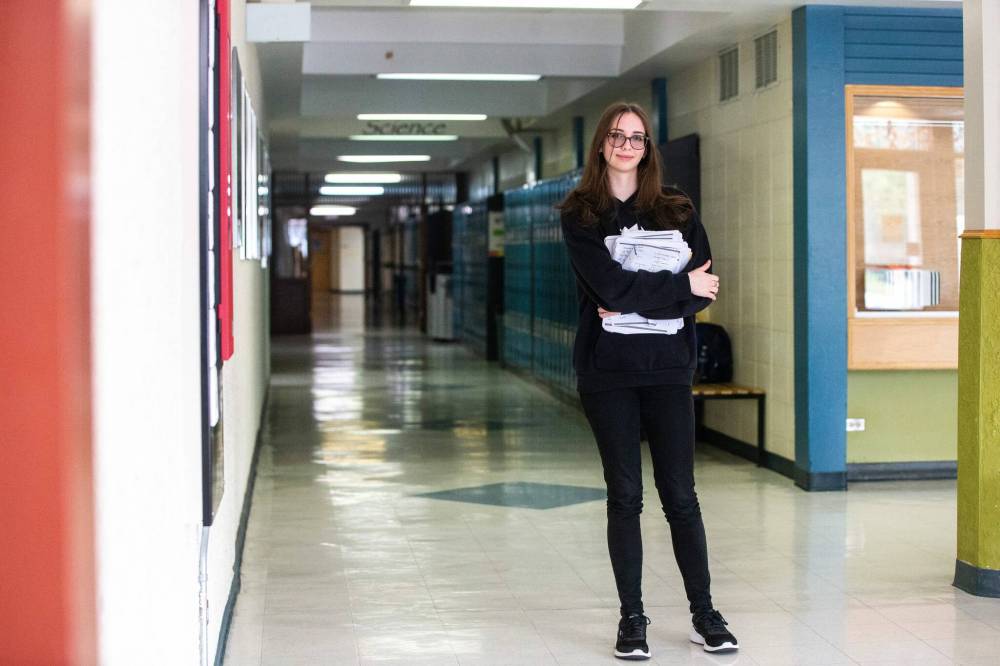
Welcome to Glenlawn Collegiate, home of the Lions and the frontier of avant-garde assessment in Manitoba’s public school system.
This spring marks five academic years since the high school, located in St. Vital within the Louis Riel School Division, officially stopped using percentage grades across its core beginner courses.
Call it “ungrading,” “de-grading” or “going gradeless” — a growing number of teachers are backing the shift and ongoing expansion of what Glenlawn’s administration dubs “progressive assessment.” The radical remodeling has observers, including staffers from the education department, keeping a watchful eye.
They are doing away with issuing numerical marks for the completion of quizzes, projects and other assignments. Instead, teachers are focusing on individual skill acquisition and using terms such as “emerging,” “progressing,” “applying” and “mastering” to categorize a student’s understanding of a learning outcome throughout a semester or school year at-large.
Manitoba Education mandates report cards reference a basic one-to-four scale in each subject area for grades 1-8. Junior high assessments must also include percentages.
In senior years, overall course grades are also to be reported via percentage, and so — against the will of dedicated ungraders — Glenlawn staff have come up with a compromise.
At the end of any given course, a student and teacher meet to analyze a portfolio of work and negotiate a number that reflects the learner’s academic performance and efforts to improve themselves. The teacher has the ultimate authority, although the model was established to challenge and “decolonize” the traditional power imbalance in education.
“It takes a lot of work to get away from the obsession of the numbers, especially if you’ve always ranked either yourself or your children on a sort-and-rank procedure,” said principal Dionne Potapinski. “To not be able to do that is so hard. It’s so hard on someone’s psyche.”
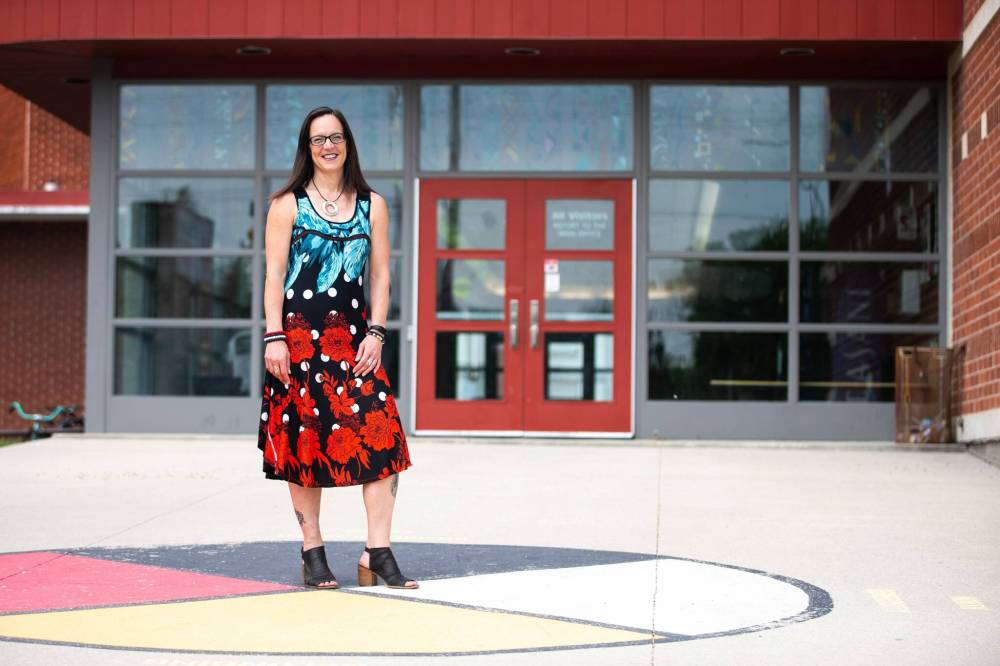
But Potapinski is dedicated to doing things differently — in her words, “doing right by teenagers” — despite the extensive research, discussion and advocacy required.
The struggling she witnessed among students grappling with academics and mental health warranted a change, she said, adding existing structures were failing First Nations students and children in foster care.
“You can only do a blanket exercise (a go-to activity at education conferences that explores the history of colonization in Canada) so many times. Unless you actually have the guts to change school, it’s not going to work,” said Potapinski, who worked in various teaching, leadership and Indigenous education roles before taking the reins at Glenlawn in 2014.
To truly support teenagers’ mental health requires more than wearing green for mental health week and stocking classrooms with granola bars, the reformist added.
Ungrading: Why Rating Students Undermines Learning (and What to Do Instead), a guide edited by Susan D. Blum, an anthropology professor at the University of Notre Dame, became her educational bible after its 2020 release.
In its introduction, Blum writes about an expanding movement to challenge the centrality of grades “as an unchanging, unyielding fact of schooling” at the end of the second decade of the 21st century.
Supporters are concerned about grading’s dehumanizing nature, the fixation on numbers leading to cheating and corner-cutting, and how it distracts from learning in and of itself, among countless issues, according to the psychological anthropologist.
Blum makes the case for leaving letter and number grades behind, citing motivation research findings that show a loss of intrinsic drive when extrinsic incentives are dominant.
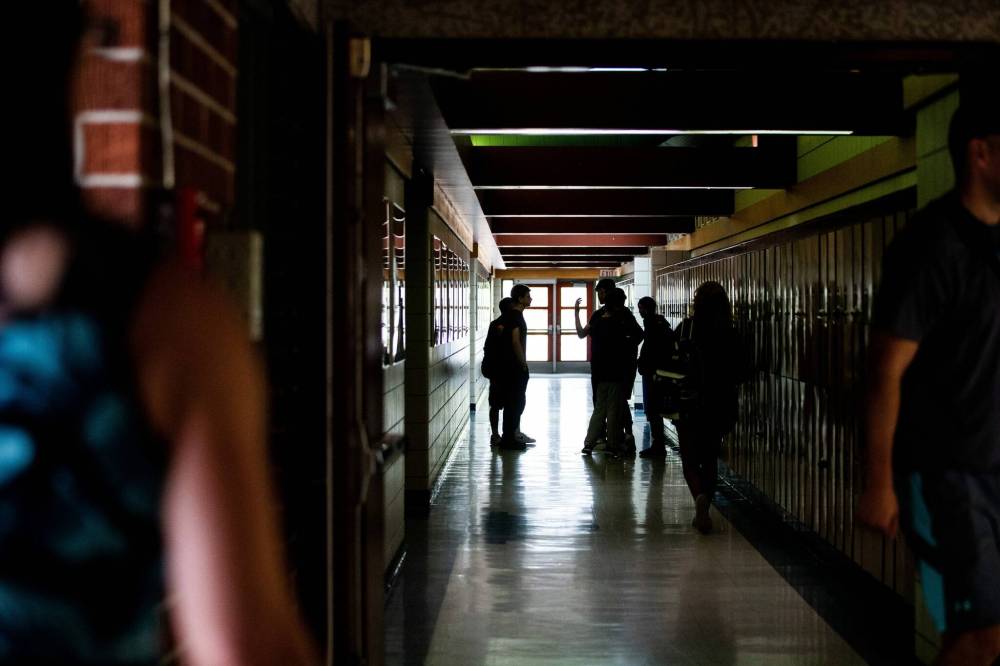
“Though grading seems natural, inevitable, a part of the very fabric of school, it isn’t,” she concludes. “Because we invented it, we can uninvent it.”
Inside a school on the corner of St. Mary’s Road and Fermor Avenue, Potapinski is encouraging a team of 120 employees to embrace that notion.
Glenlawn has created grade 9 and 10 “den systems,” a nod to the school’s big-cat mascot, to facilitate and support its assessment overhaul.
The holistic approach combines junior high and high school schedules. Teenagers study core subjects (mathematics, science, social studies, geography and English language arts) with classmates in their designated den all year.
A pair of teachers is responsible for each den with a goal of supporting incoming students’ transitions and building rapport with them between September and June.
Students are introduced to semestered courses and peers outside their dens in electives.
“We have tried our best to have a system that is personalized to each student’s needs, where we’re meeting them where they’re at and then we focus on (individual) growth,” said Grade 9 teacher Jared Suderman.
While his school was experimenting with gradeless teaching before the first COVID-19 case was detected in Manitoba, Suderman said the pandemic accelerated the transition and solidified its value.
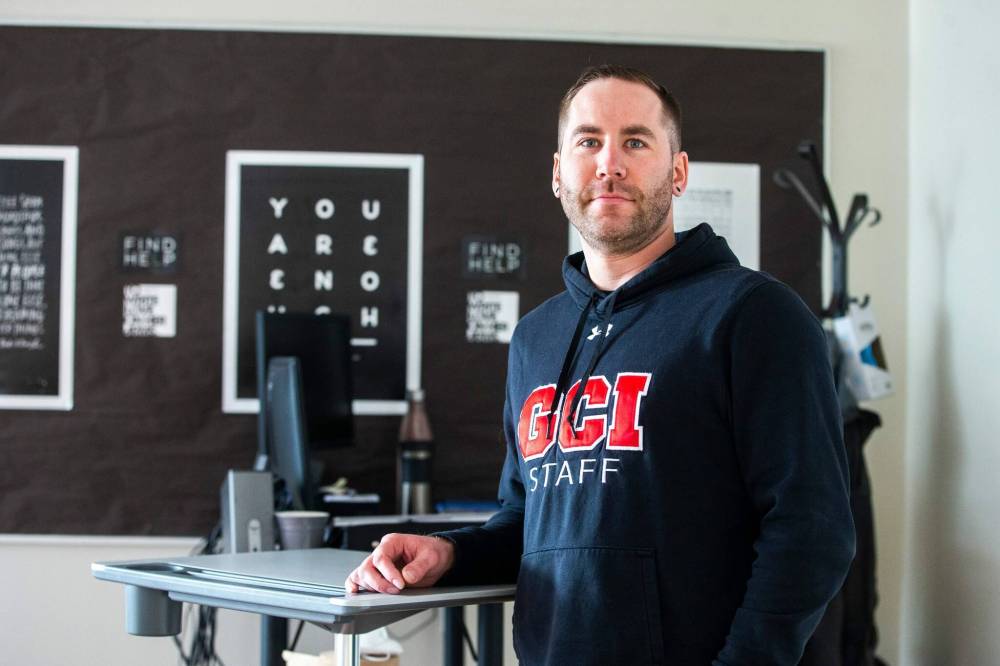
The public health crisis brought about a renewed emphasis on student well-being and with that came questions about whether high-stakes exams were appropriate.
Manitoba called off provincial exams at the end of 2019-20, owing to sudden school closures and uncertainty surrounding the resumption of in-person learning.
Grade 12 examinations, final-term tests accounting for between 20 to 30 per cent of a student’s final mark, were cancelled in 2020-21, 2021-22 and 2022-23. They are slated to make a comeback — a controversial topic in the education sector — next year.
The LRSD is among the school divisions that have opted to end heavily-weighted tests and assignments of any kind on a hyper-local level. In recent years, senior administration has directed teachers to no longer give out singular assignments that are worth more than 10 per cent of a student’s final mark.
The setup allows teachers to work beside students rather than against them, Suderman said, noting there is no more threat of “a big bad test.”
Students in his Grade 9 classroom collect evidence of their learning goals for each course outcome in the form of projects, mock exams and other submissions, none of which are marked with a number. He keeps tabs on their self-reflections and day-to-day discussions.
“Traditional assessment, at the core, is teacher-focused. It’s done for whatever is easiest — perhaps, not what is best for students. It’s focusing on high-stakes assessments. It’s focusing on numbers rather than learning, and it is done at a particular pace that some students can keep up with and not all,” he said.
Testing traditionalists question the rigour built into progressive approaches. As far as Suderman is concerned, calculating a grade on a multiple-choice unit test is far simpler than intimately knowing and being able to describe a student’s nuanced skill-set over a school year.
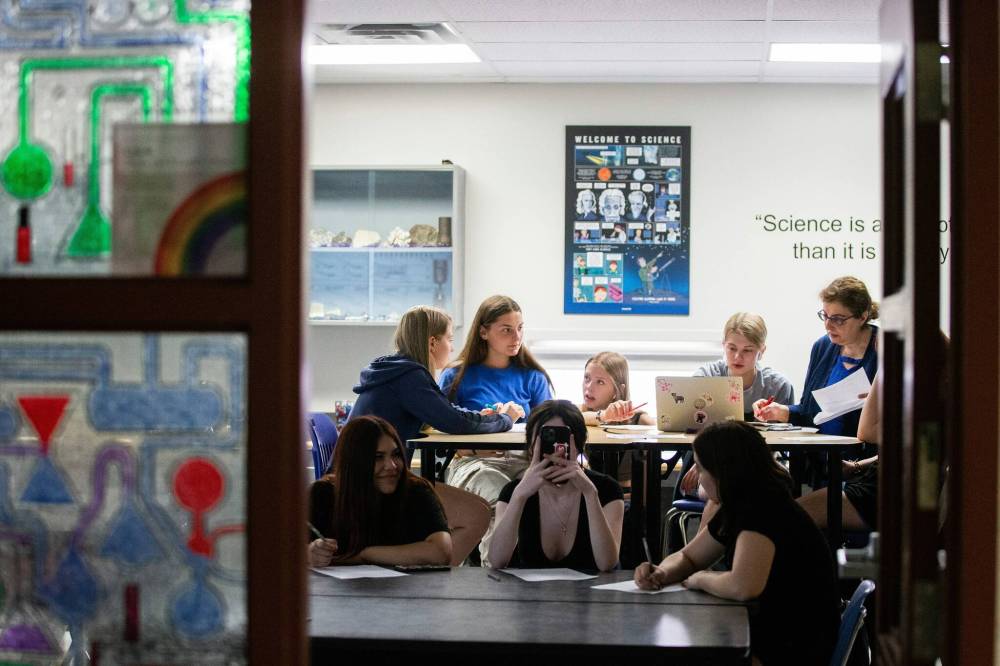
The Grade 9 teacher has eight years of experience on his teaching resumé. He began assessing students much like he was assessed in high school and how he was taught to do so inside the University of Manitoba’s education faculty.
Since updating his approach, Suderman said his students’ focus has pivoted from obsessing over a certain percentage or beating a classmate to individualized skill acquisition and personal growth.
“Grades are not benign. They cause harm, and they cause harm to learning — not (just one’s self-confidence),” said Martha Koch, an associate professor of education who researches classroom assessment at the University of Manitoba.
Koch noted extensive research suggests marks reinforce what students already believe about themselves, discourage them from taking risks, and distract pupils from the learning process because they zero-in on a number and disregard feedback attached to it.
(Karina, now a Grade 12 student at Glenlawn, said she had no choice but to pay attention to comments on her report card when the “distraction” of her grades disappeared.)
A trio of researchers at Quest University in Squamish, B.C., compared how post-secondary grading systems affect student motivation via mixed-methods study and determined extrinsic rewards did not enhance drive. Grades enhanced anxiety and avoidance of challenging courses, according to their 2018 paper published in Active Learning in Higher Education.
“In contrast, narrative evaluations supported basic psychological needs and enhanced motivation by providing actionable feedback, promoting trust between instructors and students and co-operation amongst students,” states an excerpt from the peer-reviewed journal entry.
The authors urged institutions to re-evaluate when and in which programs grades may be necessary.

Members of U of M’s education faculty recently voted to move fully to a credit/no credit system for training and graduating teacher candidates.
While Glenlawn appears to be ground zero, the local progressive assessment movement comes in many different forms, including the rising popularity of pass/fail courses and reduction of heavily-weighted assignments, Koch said.
Ultimately, the academic argues teachers need to remember the principal purpose of assessment is to boost student learning — a phrase echoed in Manitoba’s provincial assessment policy, circa 2015.
Judging the quality of student learning should happen over time through observations, conversations and student products, per the policy document.
A government spokesperson said the education department has received two public queries about ungrading at Glenlawn and has previously communicated to the LRSD that its practice “deviates from the report card guidelines.”
Department representatives have called up Potapinski on more than one occasion and paid her visits to grasp the public school’s unconventional operations.
The principal is unfazed by critics. She has done her homework on ungrading and is confident in her abilities to pitch it to skeptical students, parents and staff members — of which there are many.
“The whole premise is to have kids feel that they have worth and that they’re part of what they’re doing here and they build resilience, all of those things,” she said. “And not putting a number on somebody helps with that.”

Reflecting on her conversations with colleagues across the city, Potapinski said it is not hard to sell the ungrading concept but rather the overwhelming amount of work required to remodel an entrenched assessment program.
What Glenlawn has accomplished would not have been possible without the community’s trust in the forward-thinking teachers or dedicated time for professional development, she said.
Glenlawn’s Benjamin Storie recalls having an assessment awakening during a parent-teacher conference several years ago. It was mid-meeting that he realized he was unable to give a caregiver with concerns about their child’s performance a useful answer about how best to support the teen.
Storie said he did not want to fall back on statistics in those conversations anymore, so he leaned into holistic marking. Now, the high school teacher uses sports analogies to describe his practice and win over skeptics.
“Coaches give their players feedback. They don’t say ‘you’re a 72 per cent soccer player.’ That doesn’t exist. So how do soccer players become FIFA World Cup players? By feedback, by looking at their flaws and improving on those things,” the teacher said.
Provincial guidelines state grades should be based on what students know relative to the curriculum, be reported separately from learning behaviours, and that non-academic factors should be disregarded in determining a number.
Manitoba’s assessment and report card policies also both acknowledge the importance of a teacher’s professional judgment.
“There is no single, prescriptive way to determine final grades,” states an excerpt from the latter document, which was last updated in 2021.
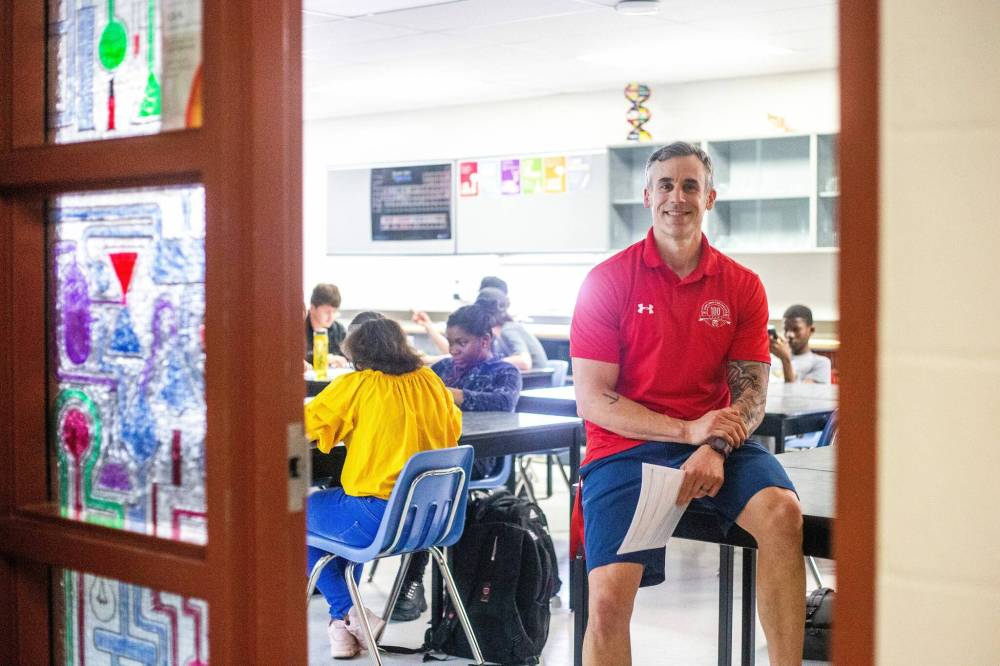
Progressive assessment’s posterboy, Alfie Kohn, argues there are nine major flaws with grades in his 1999 essay, From Degrading to De-Grading.
The American author and lecturer claims “grades aren’t valid, reliable or objective” — concern No. 4 of 9 among his bullet points criticizing final marks for distorting curriculum and spoiling students’ relationships with teachers and each other.
The Manitoba Teachers’ Society invited Kohn to speak about his views at a conference organized about two decades ago; at the time, attendees were perplexed by his radical views on schooling.
“We have this illusion that somehow teachers by themselves can assess accurately in any moment and that across the board it’s going to be the same,” said Storie, who teaches high school math and science.
It is easy to debunk that myth when you recognize teachers have unique styles and varying views on re-testing, classes are structured differently, and course times influence outcomes, he said.
Storie has repeatedly found his students do better in chemistry overall when they take it during B, C or D slots compared to the first or last period of the day. Missed buses, appointments and exhaustion are all contributing factors.
“We’re never going to be able to (accurately) compare marks,” he said. “You can’t do it and so, we just have to scrap them.”
The experienced educator said he could write a full page for every student outlining their strengths, weaknesses and skills, and predict their ability to succeed in post-secondary education based on all of the above.
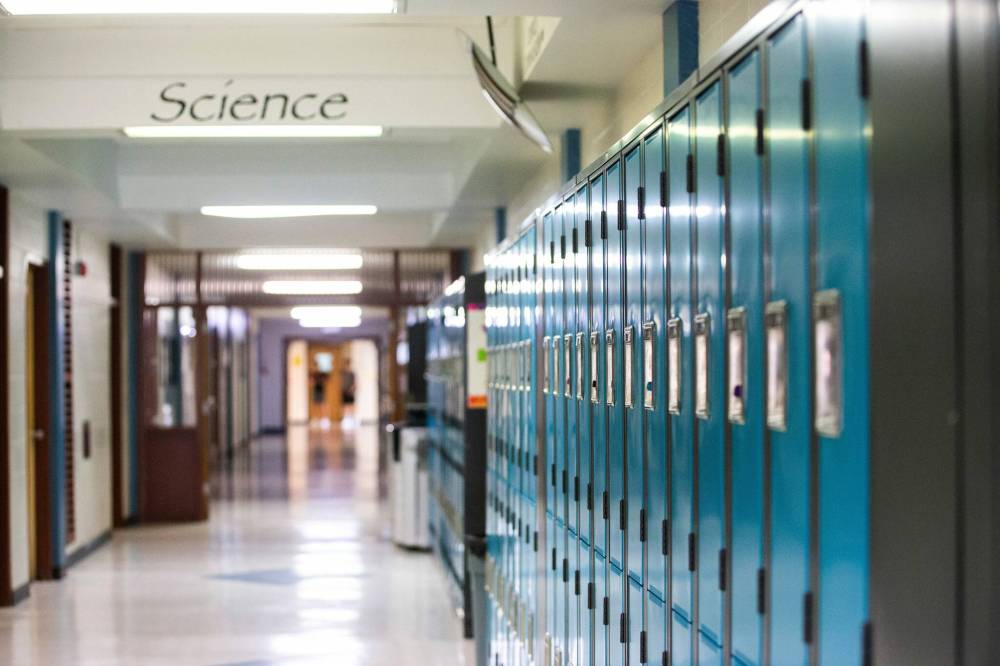
University and college admissions offices are, in their current form, arguably the greatest enemy of ungrading. Staffers primarily rely on percentages to approve and reject applications and grades are an easy way to differentiate scholarship applicants.
And yet, the only thing Storie claims is consistent about the numbers is that they are inherently inconsistent in high school and afterwards. In undergraduate courses, professors typically assign an exam that is worth a percentage of a final mark and yet they will convert the overall grade into a letter, he noted.
U of M, his alma mater, uses letter grades (D to A+) and respective grade-point values (1.0 to 4.5) to calculate grade-point averages or GPAs. Some courses leverage a pass/fail option.
Even among members of the U15, a group of Canada’s major research universities including the U of M, there is no consensus.
The University of Toronto’s grading scheme incorporates letters (F to A) and corresponding numbers (0 to 4.0) while the University of Saskatchewan relies on percentages and literal descriptors, from failure to exceptional.
Room 118 is a textbook science lab equipped with test tubes and beakers of assorted shapes and sizes, a poster of a periodic table and punny wall art. Above the main doorway, the symbols for Beryllium, Nickel and Cerium urge visitors to “Be NiCe.”
A wall-mounted illustration likens success to an iceberg, with persistence, hard work and failure all below the baby-blue water’s surface. On a nearby wall, a quote declares science is “a way of thinking.”
The classroom is a personification of its keeper, who is best known as Mr. Storie, and his beliefs about education.

Children grow up with parents, coaches and other adults “in their ear” about what is right and wrong, said Storie, who indicated his goal is to scrap that dynamic in order to build independent critical thinkers.
“If all I do is give them a test and then give an exam and then give them a mark, I’m still the voice in their ear, which is not what we want,” said the teacher, who recently completed his master’s of educational technology with a focus on self-directed learning at the University of Victoria.
“Being their own coach, that’s what will push their success.”
Instead of talking about grades, Storie, Suderman and other teachers at Glenlawn discuss specific skills with teenagers and how they can work towards mastering the task at hand via in-class assignments and homework. Verbal and written feedback are integral parts of the process.
“One of the biggest changes is the vocabulary and the words that we use because words become actions, actions become norms, and norms become the culture of your building,” Suderman said.
The four terms that have replaced percentages, ranging between “emerging” and “mastering,” are all verbs since learning never stops, he said.
Glenlawn staff describe the transformation in practice as more students are asking about what they should work on versus what their mark is. It results in a calmer, more just and positive environment because anxiety-inducing exams do not exist and both high achievers and anyone who moves closer to mastery are celebrated, according to teachers.
Administrators are still in the early stages of measuring ungrading’s influence on academic performance, but “the green zone” — the number of students attaining 80 per cent and higher — has grown since its implementation.

There has yet to be a cohort who has completed grade 9-12 in a gradeless environment, sans COVID-19 disruptions.
“It’s not harming kids, and if it feels better in the classroom, then how can we not do this?” Storie said.
For Potapinski, the most difficult time of the school year is report card season because none of her staff members want to see a student fail and putting one’s serious struggles into writing can feel like an admission of guilt.
“It is tough for people to say, ‘This kid is struggling and I, as a professional, or us, as an institution, still haven’t found a way for them not to struggle,’” the principal said.
“Drilling and killing” — a tag critics of rote learning slap on the traditional approach to education — repeatedly proved it was not the solution, she said, citing the old approach’s negative toll on student mental health.
Glenlawn’s student services team was overwhelmed with anxious students during exam weeks, which were rebranded to assessment weeks in June 2016 and scrapped entirely in exchange for additional instructional days in September 2022.
In January, as the first term of 2022-23 came to a close, Storie gave his Grade 12 chemistry class a summative exam with no percentage attached to it.
At the time, he told his students — the majority of whom are university-bound — that they should be curious about whether they “own” the course content or crammed for specific assignments and forgot about the material afterwards.
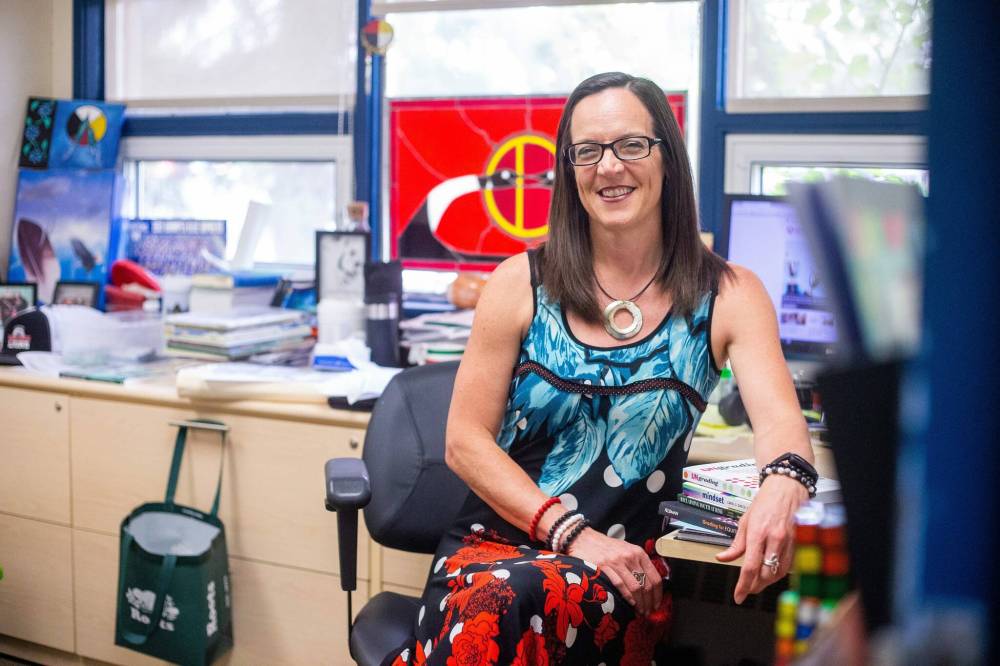
Students were later asked to collect their results, as well as unit tests, re-tests, notes, self-reflections and other materials, and prepare to pitch their teacher on an overall course mark.
“I had a mindset of negotiating my grade to see if I could get the highest possible grade that I could,” Karina said. “I was arguing for a 98, but I got a 96.”
Storie meets his students individually to go over course successes, failures and actions each teenager has taken to address the latter.
“A student like Karina re-tested, they went back, they looked at it again and they improved on that ability. That’s why her mark was so high, because she took those errors as what they were — opportunities to improve,” he said.
Karina said the way she’s been taught has given her a newfound sense of independence and self-awareness, both of which she plans to apply to her undergraduate science studies at the U of M next year.
While her teacher said he always has a mark in mind — where he sees the triangulation of data he has observed over a course — he does not tell students what it is right away and when he finally does, there is often friction.
Storie refutes the notion that grade inflation is built into the system. He is the final judge of grades and views all assessments as subjective, hence his support for abolishing “almost meaningless” marks.
“We’ve asked these students to think and improve along the way — that should manifest in higher marks, naturally,” he added.

Even when percentages must be included in final assesments, per provincial grading standards, Storie includes excerpts of self-reflections on his students’ report cards.
Alongside her 96 per cent in chemistry, a breakdown of Karina’s first semester of Grade 12 includes a personal remark: “Not having a grade has helped not give me anxiety, so that’s nice.”
maggie.macintosh@freepress.mb.ca
Twitter: @macintoshmaggie

Maggie Macintosh
Education reporter
Maggie Macintosh reports on education for the Free Press. Originally from Hamilton, Ont., she first reported for the Free Press in 2017. Read more about Maggie.
Funding for the Free Press education reporter comes from the Government of Canada through the Local Journalism Initiative.
Every piece of reporting Maggie produces is reviewed by an editing team before it is posted online or published in print — part of the Free Press‘s tradition, since 1872, of producing reliable independent journalism. Read more about Free Press’s history and mandate, and learn how our newsroom operates.
Our newsroom depends on a growing audience of readers to power our journalism. If you are not a paid reader, please consider becoming a subscriber.
Our newsroom depends on its audience of readers to power our journalism. Thank you for your support.
